 What NASA thinks we might be looking at here is an asteroid that was recently shattered by another asteroid, giving it a comet-like appearance. It stays within the asteroid belt, so it cannot be a comet as those objects are known to be dusty ice-balls that stay in highly elliptical orbits around the Sun.
What NASA thinks we might be looking at here is an asteroid that was recently shattered by another asteroid, giving it a comet-like appearance. It stays within the asteroid belt, so it cannot be a comet as those objects are known to be dusty ice-balls that stay in highly elliptical orbits around the Sun.
Daily Galaxy
Not at all meant as a “gotcha” at all… but I just love when I take the time to clean these up and people start using these my clean-ups over the ones officially released. Daily Galaxy posted my Comet Halley clean up and I knew I recognized it as my handy work. They most likely got it off Google image search.
Comet Lulin
 Currently there is a comet paying us a visit and can be seen with the naked eye. It can currently be found near Saturn in the night sky, but for those of you who lack the proper equipment and warm coats why not check out spaceweather.com’s Comet Lulin page of amatuer astrophotography.
Currently there is a comet paying us a visit and can be seen with the naked eye. It can currently be found near Saturn in the night sky, but for those of you who lack the proper equipment and warm coats why not check out spaceweather.com’s Comet Lulin page of amatuer astrophotography.
The image above is by Rich Richins taken on Feb 21, 2009. According to Rich, “Comet Lulin is nearing its peak brightness, and is showing two beautiful tails. The colors are striking. Even through the eyepiece, the tail extends easily over a degree”.
Wanderingspace’s Comet Halley #1
The Planetary Blog today posted an animation of Comet Halley captured by Vega 1 in 1986. The low quality of the Vega images reminded me of how low quality all the mission images to Halley were for their historic encounters. There was one image I found of Halley taken by Giotto that seemed to me to be the best I had ever seen in terms of detail and captured much of the coma that envelopes the nucleus as well. Here is that original image which was found at www.astro.lu.se.
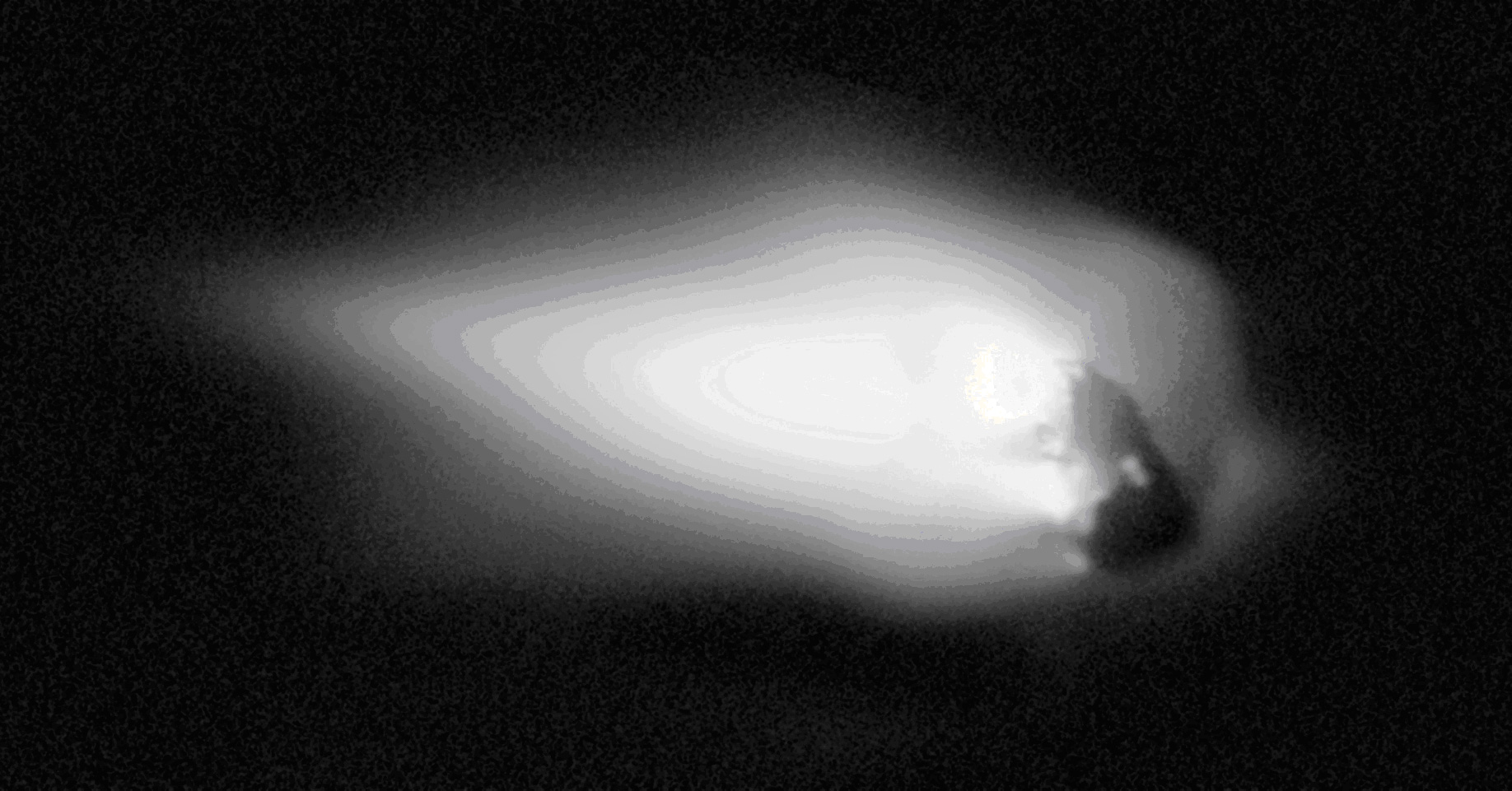
The odd thing about it is the rarity of its use anywhere and the site that provided it gives no other detail about it other than “Nucleus of Comet Halley. Giotto fly-by 1986”. So out of curiosity, I decided to do a google image search for “Comet Halley” and turns out that the wallpaper image created by wanderingspace that features this image comes up first!
In the interest of full disclosure, I thought I would post the original to show how it was beautified. Most of the work was really cleaning up the noise and removing artifacts. Much of that noise was in the form of posterization and happens in the coma. So that noise was largely blurred out since the coma would pretty much just be a large blur of white at any rate, but the rate of gradation was still maintained for some level of legitimacy. Color was added to the image last, but that is entirely artistic. That and the upper left corner of the coma which was extended to fill the frame are the only fictional parts of the image.
All in all… it seems to me that when you remove the artifacts, you pretty much have the final image which was used for the wallpaper image. Less manipulation and more “clean-up” which is what I try to do with all images here when needed.
Comet Holmes from November 4
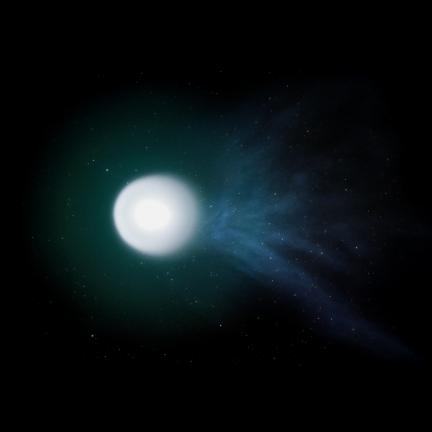 Must have missed this earlier image of Holmes. In the interest of seeing the comet better, the background stars were reduced with software and the surrounding space around it was darkened. You can see the original image here taken by Ivan Eder.
Must have missed this earlier image of Holmes. In the interest of seeing the comet better, the background stars were reduced with software and the surrounding space around it was darkened. You can see the original image here taken by Ivan Eder.
Comet Holmes from November 8, 2007
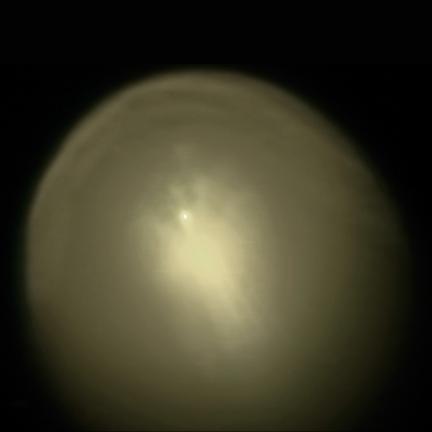 Here is Comet Holmes just a week after the previous post. The original image had multiples of star trails which have been quickly removed in Photoshop, probably resulting in some subtle “clumping” artifacts in the surrounding coma. For reference, here is the orignal by Chris Schur.
Here is Comet Holmes just a week after the previous post. The original image had multiples of star trails which have been quickly removed in Photoshop, probably resulting in some subtle “clumping” artifacts in the surrounding coma. For reference, here is the orignal by Chris Schur.
Comet Holmes from November 1, 2007
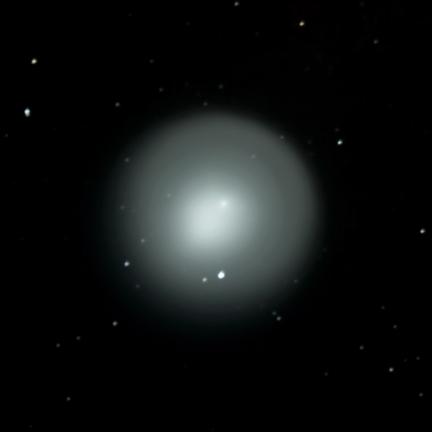 Comet Holmes is a small comet that travels between the orbits of Mars and Jupiter. The comet reappeared to observers around the time that was expected (for those who follow such objects), but the only difference was that around October 23 the comet began to get much brighter. In a 24 hour period the comet was thousands of times brighter than it had been the day before. At the time of this post, it is reported to be appear in the sky at around 1/3 the size of our moon and they say it is still expanding. There are no “official” theories as to what is causing the activity, but many assume that there had been some kind of collapse of materials on the surface which would then cause a large amount of material to escape into the space around it.
Comet Holmes is a small comet that travels between the orbits of Mars and Jupiter. The comet reappeared to observers around the time that was expected (for those who follow such objects), but the only difference was that around October 23 the comet began to get much brighter. In a 24 hour period the comet was thousands of times brighter than it had been the day before. At the time of this post, it is reported to be appear in the sky at around 1/3 the size of our moon and they say it is still expanding. There are no “official” theories as to what is causing the activity, but many assume that there had been some kind of collapse of materials on the surface which would then cause a large amount of material to escape into the space around it.
The comet seems to lack the usual comet tail and appears to be fuzzy and round, as we are looking at Holmes straight down through the tail end of it from our position here on Earth. The comet was originally discovered in 1892 due to a similar outburst which now seems to be repeating itself.
The image above was provided by wikipedia.com and only credits the image as being submitted by user Spanto and was taken in Barcelona , Spain, dated Nov 1 2007.
Stardust Extended Mission Target Is…
Soon after the Stardust mission flew in close and collected tiny samples of comet dust in Jan 2004 from the comet Wild 2, the spacecraft was placed into hibernation mode – only to be awakened for occasional health status calls.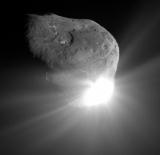 A proposal to extend the mission into Stardust-NExT suggests the spacecraft be sent on a trajectory to encounter comet Tempel 1. The main objective of this mission would be to image the crater left behind by the Deep Impact mission of 2005. That mission did not manage to image the resulting crater due to the huge amount of dust blasted off from the impact (pictured above-left) which blocked the view until well after DI’s cameras were out of range to see any details on its surface. The final decision on this extended mission is expected this May/June and should it be approved… it is expected that Stardust-NExT would reach Tempel 1 at some point around 2010.
A proposal to extend the mission into Stardust-NExT suggests the spacecraft be sent on a trajectory to encounter comet Tempel 1. The main objective of this mission would be to image the crater left behind by the Deep Impact mission of 2005. That mission did not manage to image the resulting crater due to the huge amount of dust blasted off from the impact (pictured above-left) which blocked the view until well after DI’s cameras were out of range to see any details on its surface. The final decision on this extended mission is expected this May/June and should it be approved… it is expected that Stardust-NExT would reach Tempel 1 at some point around 2010.
Wallpaper: Deep Impact Makes Contact
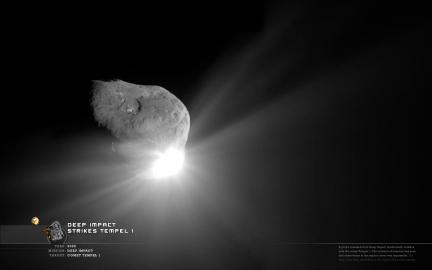 One of the expectations of ramming a space probe into a comet was to be able to see the resulting crater. The Deep Impact collider was released and the Deep Impact probe continued on from a distance to record the impact. What it saw was a blast much larger than expected and was so large that direct visual observance of the resulting crater became impossible. However, the same thing which kept us from seeing some of these results is the same plume of ejected material that has told us that more about this comet’s composition and how the surface materials are held together quite weakly.
One of the expectations of ramming a space probe into a comet was to be able to see the resulting crater. The Deep Impact collider was released and the Deep Impact probe continued on from a distance to record the impact. What it saw was a blast much larger than expected and was so large that direct visual observance of the resulting crater became impossible. However, the same thing which kept us from seeing some of these results is the same plume of ejected material that has told us that more about this comet’s composition and how the surface materials are held together quite weakly.
Wallpaper: Comet Wild 2
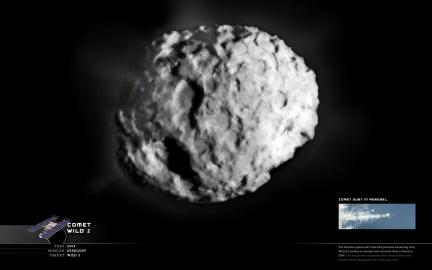 When the Stardust spacecraft passed nearby the comet Wild 2, it opened up a container that held a material called aerogel exposing it to high velocity particle impacts originating from the surface of Wild 2. You can see the haze and jet streams of these particles flowing from various points on Wild 2 and creating what is known as the coma around the comet nucleus. Once the encounter was completed, the Stardust spacecraft returned the samples captured to Earth, in 2006, and successfully completed one of the very few robotic sample return missions ever attempted.
When the Stardust spacecraft passed nearby the comet Wild 2, it opened up a container that held a material called aerogel exposing it to high velocity particle impacts originating from the surface of Wild 2. You can see the haze and jet streams of these particles flowing from various points on Wild 2 and creating what is known as the coma around the comet nucleus. Once the encounter was completed, the Stardust spacecraft returned the samples captured to Earth, in 2006, and successfully completed one of the very few robotic sample return missions ever attempted.
WALLPAPER NOTE: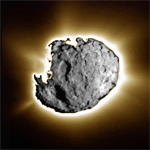 The wallpaper image itself has been greatly reverse manipulated. The most common image from this mission to be found in any publication, or by doing a Google search, is the one seen at left. This image is obviously enhanced and most notably in the edges on the upper left, look absolutely fake. However, what looks like glowing light around this image is based upon data actually captured by the Stardust cameras of dust and gas flowing from Wild 2’s surface. So it was possible to go back to the original nucleus image, re-mask it and then re-apply the jet streams and coma information in a more realistic way… which is what I did. An image is also provided in the wallpaper of what a small segment of the aerogel and a small cometary dust particle looks like. This aerogel is the lightest solid ever created and its invention is what made the Stardust mission even possible. The blast markings are, for the most part, only impact marks left in the aerogel. Look carefully and you will see tiny white particles at the far end of these blast marks which are pieces of comet Wild 2 itself returned to us here on Earth. Probably the most pristine bits of material ever obtained by mankind from what is considered to be left overs from the earliest days of the formation of the solar system.
The wallpaper image itself has been greatly reverse manipulated. The most common image from this mission to be found in any publication, or by doing a Google search, is the one seen at left. This image is obviously enhanced and most notably in the edges on the upper left, look absolutely fake. However, what looks like glowing light around this image is based upon data actually captured by the Stardust cameras of dust and gas flowing from Wild 2’s surface. So it was possible to go back to the original nucleus image, re-mask it and then re-apply the jet streams and coma information in a more realistic way… which is what I did. An image is also provided in the wallpaper of what a small segment of the aerogel and a small cometary dust particle looks like. This aerogel is the lightest solid ever created and its invention is what made the Stardust mission even possible. The blast markings are, for the most part, only impact marks left in the aerogel. Look carefully and you will see tiny white particles at the far end of these blast marks which are pieces of comet Wild 2 itself returned to us here on Earth. Probably the most pristine bits of material ever obtained by mankind from what is considered to be left overs from the earliest days of the formation of the solar system.
Wallpaper: Comet Halley
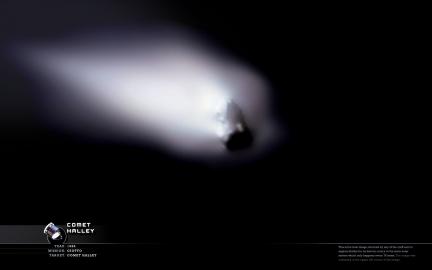 When comet Halley last swung into the vecinity of the inner solar system, it was one of the lesser impressive apparitions in probably hundreds of years. In previous visits, the Halley either fascinated or horrified people everywhere. It was, as I would imagine, an object one could not ignore hanging in the sky above. Instead of a glorious vision in the sky, 4 independent probes were launched for the historic event to see what Halley was really all about.
When comet Halley last swung into the vecinity of the inner solar system, it was one of the lesser impressive apparitions in probably hundreds of years. In previous visits, the Halley either fascinated or horrified people everywhere. It was, as I would imagine, an object one could not ignore hanging in the sky above. Instead of a glorious vision in the sky, 4 independent probes were launched for the historic event to see what Halley was really all about. 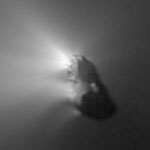 The one that returned the best images was the European Giotto probe which got in pretty close and returned the above image.
The one that returned the best images was the European Giotto probe which got in pretty close and returned the above image.
IMAGE NOTE: The image above is one rarely posted and may be a more recent “clean-up” version of the one more commonly seen when doing a google search for comet halley (seen at left here). The only alterations I made to this was to extend the slight haze beyond the tail so that it runs off the upper left hand side of the cropping. Color is ever so slightly enhanced from the original. Now whether or not the original was enhanced… that I don’t know.